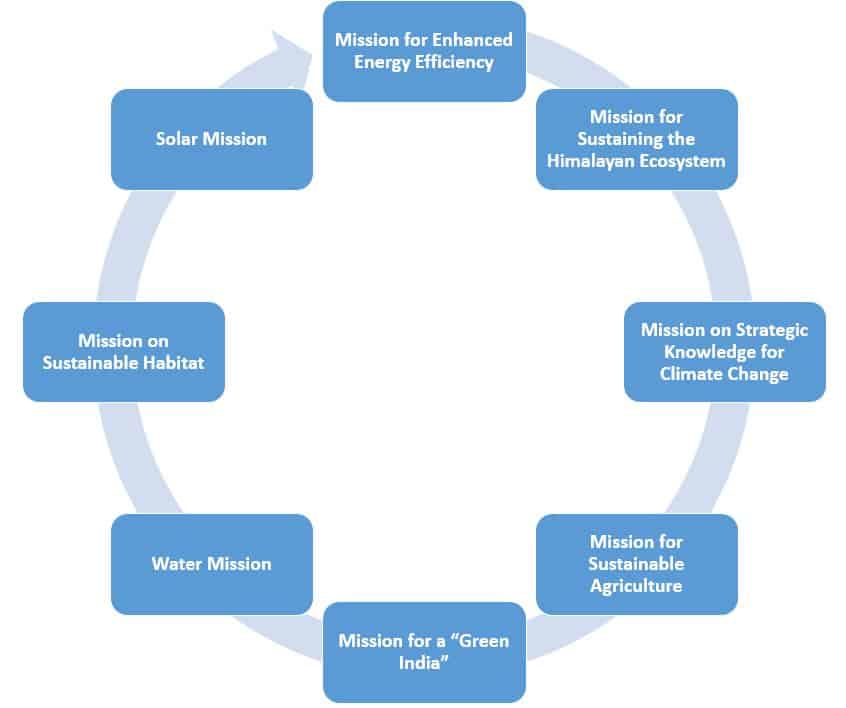What is National Action Plan on Climate Change (NAPCC) 2008?
National Action Plan on Climate Change or NAPCC is an action plan prepared by Prime Minister’s council on 30th June 2008 to tackle climate change. The reason behind its formulation was concern to mitigate climate change which is threatening humans. India currently houses approx. 17% of world’s population and thus it becomes important to take measures to combat climate change. Considering the high growth rate in the country it becomes important to manage its resources to sustain the high growth rate.
NAPCC tries to address the urgent and critical need of the nation by changing/adjusting the policies for development. This will also help in increasing efficiency and achieving sustainability. This action plan has also been submitted to United Nations under United Nations Framework Convention on Climate Change (UNFCCC) under India’s Intended Nationally Determined Contribution (INDC).

How NAPCC is being implemented?
NAPCC is being implemented in various stages and parts by means of 8 missions under it. These 8 missions covers different aspects related directly and indirectly to climate change like sustainable habitat, energy need, focus on renewable energy, enhanced energy efficiency, clean drinking water, sustaining the Himalayan Ecosystem, conserving and creating green spaces, better agriculture and knowledge creation about climate change. India is actively engaged in multilateral negotiations in the United Nations Framework Convention on Climate Change (UNFCCC) , under this India is determined to keep its per capita greenhouse gas emissions lower than that of developed countries. NAPCCC is guided by following principles:
- Protecting the poor & vulnerable sections of the society through an inclusive and sustainable development strategy, sensitive to climate change
- Achieving national growth objectives through a qualitative change in direction that enhances ecological sustainability, leading to further mitigation of greenhouse gases
- Devising efficient and cost-effective strategies for end use Demand Side Management
- Deploying appropriate technologies for both adaptation and mitigation of greenhouse gases emissions extensively as well as at an accelerated pace.
- Engineering new and innovative forms of market, regulatory and voluntary mechanisms to promote sustainable development
- Effecting implementation of programmes through unique linkages, including with civil society and local government institutions and through public private partnership
- Welcoming international cooperation for research, development, sharing and transfer of technologies enabled by additional funding and a global IPR regime that facilitate technology transfer to developing countries under UNFCCC.
There are Eight National Missions under NAPCCC which represents the multi – pronged, long-term and integrated strategies for achieving key goals in context of climate change. These missions are:

8 missions of NAPCC are:
- National Solar Mission: The NAPCC aims to promote the development and use of solar energy for power generation and other uses with the ultimate objective of making solar competitive with fossil-based energy options.
- National Mission for Enhanced Energy Efficiency: Current initiatives are expected to yield savings of 10,000 MW by 2012. Building on the Energy Conservation Act 2001.
- National Mission on Sustainable Habitat: To promote energy efficiency as a core component of urban planning.
- National Water Mission: With water scarcity projected to worsen as a result of climate change, the plan sets a goal of a 20% improvement in water use efficiency through pricing and other measures.
- National Mission for Sustaining the Himalayan Ecosystem: The plan aims to conserve biodiversity, forest cover, and other ecological values in the Himalayan region.
- National Mission for a “Green India”: Goals include the afforestation of 6 million hectares of degraded forest lands and expanding forest cover from 23% to 33% of India’s territory.
- National Mission for Sustainable Agriculture: The plan aims to support climate adaptation in agriculture through the development of climate-resilient crops, expansion of weather insurance mechanisms, and agricultural practices.
- National Mission on Strategic Knowledge for Climate Change: To gain a better understanding of climate science, impacts and challenges, the plan envisions a new Climate Science Research Fund, improved climate modeling, and increased international collaboration.
Read about: International Solar Alliance, Climate Change & Global Warming , Types of Water Pollution